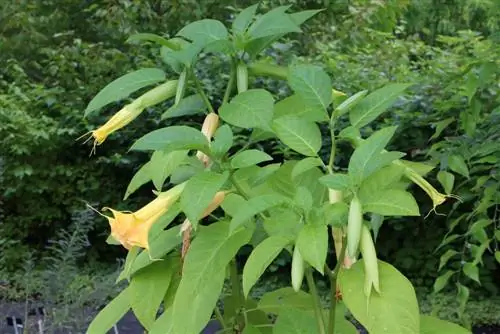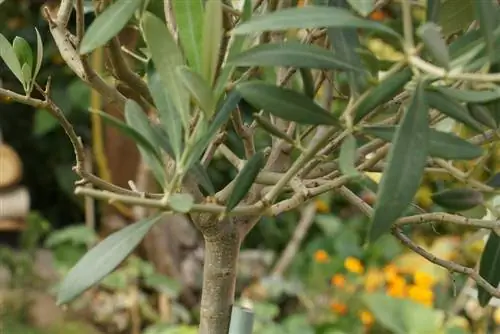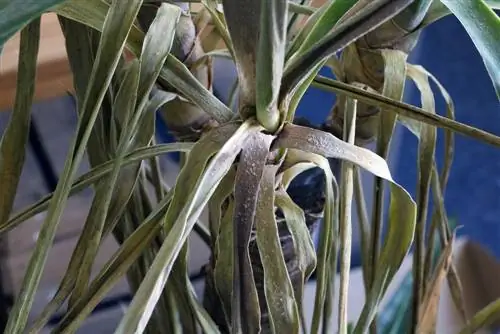- Author admin [email protected].
- Public 2023-12-17 03:39.
- Last modified 2025-01-24 12:45.
Far away from the sun-drenched, mild regions of the Mediterranean, the Central European climate can sometimes put an olive tree in distress. Wet, cold winters and rainy summers weaken its resistance, so that it can no longer defend itself against attacks by pathogens on its own. Anyone who is an olive gardener and is familiar with the potential dangers can help their precious tree in good time. Therefore, familiarize yourself with common diseases and pests. Read here how to recognize the symptoms and combat them effectively.
Summary Overview
On an olive tree you will be confronted with diseases and pests of various origins. The following overview shows which harmful effects this guide deals with in detail:
Common diseases
- Eye spot disease (Spilocaea oleagina)
- Olive crab (Pseudomonas syringae)
- Fire bacterium (Xylella fastidiosa)
- Leaf yellowing (chlorosis)
Common Pests
- Scale insects (Coccoidea)
- Otiorhynchus
- Meadowfoam cicada (Philaenus spumarius)
So that you can later enjoy olives from your own harvest without any worries, the recommended control measures focus on environmentally and he alth-friendly methods. Only when an ecological approach is proven to be unsuccessful do chemical-based agents come into focus.
Eye spot disease (Spilocaea oleagina)
Eyespot disease is feared because this fungal infection is widespread and can also affect the large olive plantations on the Mediterranean. You can recognize the disease by these symptoms:
- Dark brown spots with a light border appear on infected leaves
- In the advanced stage, a leaf turns completely yellow and dies
- Wet summer weather increases the infestation pressure
The first step in combating the disease is to remove all affected leaves and dispose of them in the trash can. Since the fungal spores specifically seek their way from living leaf to living leaf, you contain the infection in this way. As a precaution, fallen leaves should also be removed. Since the infection spreads very slowly, consistent action may make further control measures unnecessary. If the eyespot disease has already infected the entire crown, treat it with a fungicide. The two preparations Fungisan rose and vegetable mushroom-free and Atempo mushroom-free from Neudorff have proven themselves well in practice.
Olive crab (Pseudomonas syringae)
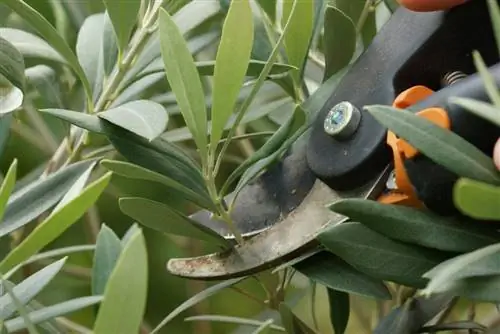
From Europe to South Africa and North America, a bacterium is making life difficult for commercial and private olive gardeners. The rod-shaped Pseudomonas syringae spares neither herbaceous nor woody plants and also has your olive tree in its sights. The pathogen uses every tiny wound as an entry point to nestle deep in the tissue. Cancerous growths then form. The first symptoms appear beforehand:
- Brown discoloration on the branch bark that tears lengthwise
- Thin branches die, thicker branches stop growing in thickness
- Black or dark red lesions form on the trunk, which gradually sink in
- In the advanced stage, the cells of the cambium proliferate outwards
Immediately effective control agents are not available, neither in ecological nor in chemical form. Infected plant parts should be cut out and burned. Since infection often occurs through unclean scissors and knives, these should always be disinfected. A rain-protected location and avoiding overhead irrigation also help ensure that the olive canker pathogens do not find a target. Furthermore, choose a date for pruning in the spring when the wounds heal quickly. If frost damage occurs in the form of cracks in winter, use a wound closure agent to prevent the bacteria from accessing your olive tree.
Fire bacterium (Xylella fastidiosa)
The fire bacterium has already caused such devastating damage to olive tree growing areas on several occasions that the European Commission became involved. Since 2015, commercial olive gardeners in all European member states have been obliged to dispose of all olive trees within a radius of 100 meters of a plant infected with Xylella fastidiosa, regardless of their he alth status. The experts were forced to take this drastic measure because there are no remedies against this destructive disease. In 2016, the fire bacterium was also detected in Germany. The symptoms are easy to diagnose:
- The bacterium settles in the xylem of the olive tree
- The pipelines running here are blocked
- The supply of water and nutrients is stopped
- Leaves, shoots and flowers yellow, dry out and die
At first glance, an affected olive tree shows all the signs of drought stress. Unfortunately, the first symptoms only appear weeks and months after the infection. The main vectors are meadow leafhoppers and other insects. The fire bacterium is not limited to olive trees. The more than 200 host plants include almond, peach and lemon trees as well as oleander and other Mediterranean plants. If this disease is suspected, the olive tree should be completely cleared and burned.
Leaf yellowing (chlorosis)
The olive tree is one of the few lime-tolerant plants in the Mediterranean garden. However, if the lime content in the soil or container substrate becomes excessive, the leaves turn yellow. The cause of this is not a plant disease, but a lack of iron and magnesium. These micronutrients are present in sufficient quantities in the soil. Too high a lime content in the alkaline range greater than 8 blocks the absorption of trace elements. The signs of leaf chlorosis are unmistakable:
- The leaf surfaces turn yellow from the tips and edges
- The leaf veins retain their green color, creating a mosaic pattern
- As it progresses, the leaves turn brown and fall off
To compensate for the deficiency in the short term, we recommend foliar fertilization with an iron chelate fertilizer for the olive tree, such as Ferramin from Neudorff or Fetrilon from Compo. To eliminate the nutrient deficit in the long term, repot an olive tree in a bucket into fresh substrate with a pH value between 7 and 8. On a planted Olea europaea, loosen the soil and incorporate peat, ericaceous soil or leaf compost.
Scale insects (Coccoidea)
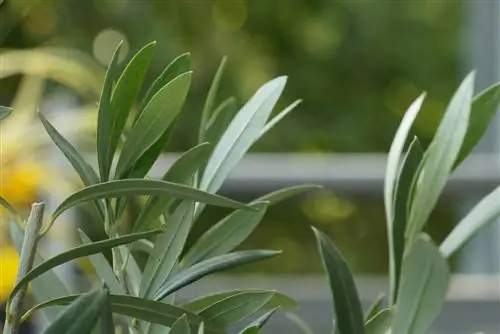
An olive tree in permanent indoor cultivation offers scale insects a popular target with evergreen leaves. This applies equally to lid lice, bowl lice and mealybugs. The pests use their pronounced mouthparts to pierce the leaf tissue to get the sought-after plant sap. If this activity is not put to a stop, the tree will slowly die under the growing pressure of infestation. The presence of scale insects can be recognized by these signs:
- Small green or brown bumps on the tops and bottoms of the leaves
- Mealybugs weave white webs on the leaves and in the leaf axils
- Mealybugs hide under white cotton balls on the leaves
- Crippling leaves and flowers
- Shoots and branches become crusty and deformed
By placing your olive tree outdoors until the first frost, you can avoid this pest without further action. If the scale insects have already discovered the tree, rub the colonized leaves with a soft cloth soaked in alcohol. Infested areas that are difficult to reach can be repeatedly dabbed with cotton swabs that you have previously dipped in alcohol. Furthermore, the classic soap solution at least gets rid of lice without a shield or lid. The scale insects, which are equipped with a shell, are effectively combated naturally using diatomaceous earth, a powder made from sedimentary rock.
Tip:
An infestation with scale insects can at first glance be confused with olive cancer. Before you worry about clearing your olive tree, examine the areas in question carefully by taking a close look using a magnifying glass.
Otiorhynchus
They are black, 10 mm long and move out at dusk to look around the garden for food. The black weevils don't ignore an olive tree with its dense, evergreen foliage. How to recognize an infestation of black weevils:
- Adult beetles leave the characteristic bay food on the leaves
- Females lay up to 800 eggs on the roots, which gnaw on the roots as larvae
- Under high infestation pressure, deficiency symptoms occur on the olive tree, such as hanging leaves and shoots
There is a whole arsenal of environmentally friendly means at your disposal to combat it. The voracious larvae are reliably destroyed with nematodes. These nematodes are applied with a watering can or a plant protection syringe and parasitize the larvae. Repeated use is required for optimal success. Bait traps whose grooves are filled with a gel made from nematodes can be set out against adult black weevils.
If you don't want to condemn the beetles to death, hang buckets filled with wood shavings upside down in the garden. The weevils cannot resist the inviting retreat, crawl in and can be relocated to a safe location during the day.
If fighting with nematodes is too time-consuming, incorporate neem press cake into the substrate. The neem oil contained in it is absorbed through the roots of the olive tree and stops larvae and beetles from eating. It is important to note that nematodes and neem must not be used at the same time, as neem oil is toxic to the beneficial insects.
Meadowfoam cicada (Philaenus spumarius)
Until a few years ago, the meadowfoam leafhopper did not play a significant role in the ranking of common pests on the olive tree. Only when the larvae appeared in large numbers and sucked on the leaves were they rinsed off with a sharp jet of water. Since insects were identified as the main vectors of the fire bacterium, consistent control has become the focus. How to recognize an infestation:
- In May and June the green larvae cover themselves in a white foam
- The sucking activity causes pustules arranged in rows on leaves, shoots and twigs
- Adult insects are elongated and broad in shape and light brown to dark brown in color with light spots
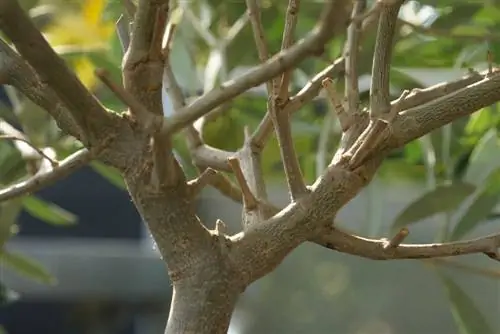
By hanging sticky traps in the olive tree immediately after wintering, the females are prevented from laying eggs. Since the larvae are part of the ants' prey pattern, you can draw the attention of the beneficial insects to the tree with sugar water. Where the white foam forms, it is rinsed off with water. You can effectively combat meadowfoam leafhoppers and their larvae with an environmentally friendly neem oil-based insecticide.
Resistant olive varieties
Since olive trees have been cultivated for centuries, a wide range of proven varieties is now available. Naturally, the focus in German ornamental gardens is on reliable winter hardiness. This is not contradicted by the fact that some established breeds have proven to be largely resistant to diseases. The following selection introduces you to recommended olive varieties in more detail:
Leccino
One of the leading olive varieties comes from Tuscany and enjoys worldwide popularity. The outstanding attributes are good winter hardiness down to -11.9 degrees Celsius, vigorous growth, tasty fruits and reliable resistance to diseases.
Hojiblanca
The olive variety, which is widely grown in Spain, is also becoming increasingly common in Central European gardens. A scientific study by the University of Cordoba gave confidence in their winter hardiness down to -9.9 degrees Celsius. Properly cared for in full sun, the premium breeding from Andalusia acquires sufficient defenses against diseases and pests.
Alandaou
The lover variety is native to France. Aglandou is the ideal olive tree for a distinctly alkaline soil with a pH of 8 to 8.5. The highly branched root system contributes significantly to reliable frost tolerance. The he althy foliage knows how to fend off diseases and pests as long as it is not exposed to constant rain. The French breeder Olivier d’Auge sends young plants from his own breeding to Germany via parcel delivery upon request.
Arbequina
This olive variety from Catalonia has been proven to withstand temperatures down to -11.8 degrees Celsius. Their small fruits are ideal for fresh consumption and produce a premium quality oil. Its corkscrew-like trunk is unmistakable and attracts everyone's attention. Arbequina is one of the selected varieties that can be discovered in German specialist retailers as it is rarely affected by diseases and pests.
Tip:
In the wild, olive trees like to look for a location with a high s alt content in the air. By spraying the tree in spring with a light s alt solution of 15 grams of s alt in 1 liter of water, the ideal Mediterranean conditions of the saline Mediterranean climate are simulated.
Conclusion
Skillful wintering is not the only challenge in cultivating olive trees. If an Olea europaea is weakened due to neglect in care or frost damage, diseases and pests take advantage of the opportunity. An excess of moisture causes eye spot disease or olive cancer. New to the list of common diseases is the fire bacterium, against which all combat strategies have so far been ineffective. After all, leaf chlorosis can be remedied with simple measures, such as foliar fertilization with iron. Olive gardeners are rarely confronted with pests such as scale insects as long as the tree experiences temperatures around freezing point, at least for some time. In summer, the appetite of the black weevil should not be underestimated. At the same time as the fire bacterium, the meadowfoam leafhopper, which was previously classified as harmless, has come into focus because it is considered a vector of the pathogen.


